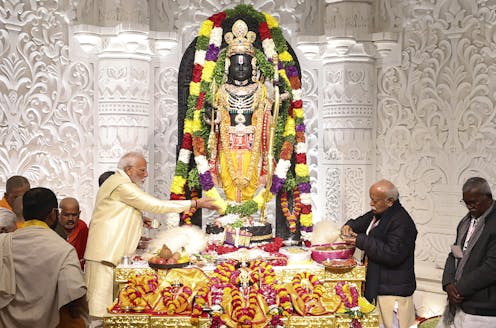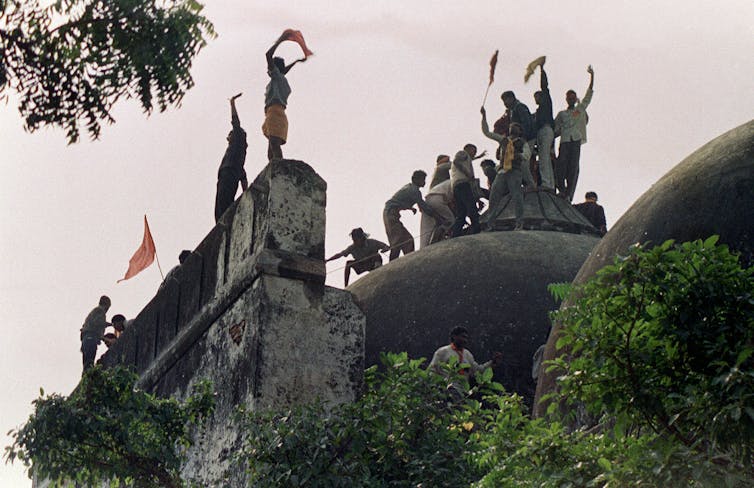The opening of India’s new Rama temple made waves – but here’s what the central ritual actually mean
A scholar of Hinduism explains the importance of the consecration ritual, which is believed to bring the presence of the divine into the temple.

The consecration rituals of the icon of Lord Rama were performed in a newly built mega-temple in the town of Ayodhya, India, on Jan. 22, 2024. The prime minister of India, Narendra Modi, performed the rituals during a 48-minute period considered auspicious by Hindu astrologers. Lord Rama, an avatara or incarnation of Vishnu, is one of the most important deities in the Hindu tradition.
Amid the carefully staged pageantry, the media’s hysteria over the guest lists and the celebrations of exultant Hindus – not just in India but from Golden Gate Bridge to Times Square – the religious significance of the rituals, known in Sanskrit as “prana pratishtha,” or “establishment of breath,” was completely lost.
Media all around the world, particularly in India, referred to the icon of Lord Rama as an “idol.” However, the term does not capture the Hindu belief that matter transforms into divine reality during this ritual. Although there are many nuanced Sanskrit words, there is no English term that does justice. In fact, the word “idol” has pejorative implications.
As a professor of religion who has studied the religious significance of deities in temples, I want to highlight this important ritual, which is said to transform the material image.
From matter to deity
The ritual of “prana pratishtha” is a culmination of several days or even weeks of preparation. At crucial moments during the performance of the ritual, many Hindus, though not all, believe that the divine being comes to abide in a carefully carved icon.
In an idea roughly analogous to transubstantiation in the Catholic Church – where, when the priest consecrates the bread and wine, the whole substance of the bread and wine is believed to become the body of Christ – through prana pratishtha, the material icon becomes a divine presence.
Although several Hindu texts speak of the supreme being as being beyond form, gender and even number, paradoxically, Hindus also see the supreme entity as graciously taking a “material” form and abiding in a temple as an incarnate deity worthy of worship.
Despite textual and regional variations, there are many common practices in this ritual. During the process of prana pratishtha, this image carved by a master sculptor is initially purified, then covered in water, grains, fragrant substances, herbs, flowers and other materials. In doing so, it is said to absorb the energies of the universe. Texts called “Puranas” and “Agamas,” composed in the first millennium C.E., give many details for the procedure.
There are fire sacrifices in a pavilion outside, the deity is taken formally into the temple and also in a procession through the town, and there is recitation of mantras.
Precious stones and metals, as well as a yantra, a metal plate with geometrical drawings, are buried in the ground in the inner shrine where the deity is to be installed.
The eyes of the icon are also ritually opened. Since the unrestricted power or “shakti” of the deity is believed to blaze out through its gaze, a mirror is held in front of it both to guide the sculptor in opening the eyes carefully and also to reflect the power back to it. In Ayodhya, a scarf was removed from the eyes of the deity.
At the crucial time, the chief priest invokes the divine being, inviting it to abide in the icon. With the opening of the eyes and the invoking and transfer of breath, the material icon is said to be transformed into an incarnation of the deity.
Controversies over the temple land
The “prana pratishtha” rituals have been done in thousands of temples in India and globally. But the Ayodhya one has arguably drawn the most attention politically and has also been the most controversial.
The new temple has been built on the land where a 16th century mosque – the Babri Masjid – was destroyed by Hindu activists in December 1992. Some Hindus claim that the mosque had been built by razing a 15th century Rama temple, said to be the site of his birth. While there seems to be evidence that a temple stood where the mosque was built, scholars have disputed the claim that that spot was the very one where Rama was born. Representatives of Jainism, another ancient religion of India, have also claimed that a sixth century Jain temple existed on this site before the mosque was built. Several scholars have argued that the destruction of the mosque is directly connected with Hindu nationalism and communal violence.

Hindus’ and Muslims’ rights to worship at the site have been litigated for more than a hundred years, and in 2019, the Supreme Court of India ruled that the land be given to a Hindu trust and a five-acre lot be given to the Muslims to build a mosque. Building the temple was started soon after this judgment.
Politically, the attention accompanying the rites highlighted the metaphor of Rama “returning home.” It refers to an incident in the story of Rama as told in the ancient epic, the “Ramayana,” when he is exiled from Ayodhya on the eve of his coronation and returns home after 14 years of exile.
Devotees’ sentiments as well as speeches at the inauguration of the temple spoke of Rama’s return to Ayodhya after 500 years of being banished from his birthplace.
It was a clear reference to what the government and many Hindus believed to be a return of Rama to Ayodhya after his presence was “banished” with the building of the mosque in the 16th century.
‘Not in our names’
There were many Hindus who objected to the politicization of the event as well as the active role of the government and its agencies in the ritual fanfare. Indian Air Force choppers rained flowers on the temple after the consecration.
Some observers, including outsiders sympathetic to Hinduism, saw these rituals as a glorification of Modi, not Rama. The event was also contested in religious circles. Several monastic heads refused to join the event, but a prominent Hindu writer said that these religious leaders were not representative of Hinduism and refuted their objections.
Despite these controversies, for those Hindus who supported the building of the temple, it was a sacred moment. For during the prana pratishtha, the divine is said to become present in the icon, if the rituals are properly performed. The “idol” made of material substance is then transformed, and the temple becomes the home for the deity.
Vasudha Narayanan does not work for, consult, own shares in or receive funding from any company or organization that would benefit from this article, and has disclosed no relevant affiliations beyond their academic appointment.
Read These Next
As DOJ begins to release Epstein files, his many victims deserve more attention than the powerful me
Powerful men connected to Jeffrey Epstein are named, dissected and speculated about. The survivors,…
The world risks forgetting one of humanity’s greatest triumphs as polio nears global eradication − 7
Polio may finally be defeated in the next 5 years. Will the world recognize what an extraordinary achievement…
Medieval peasants probably enjoyed their holiday festivities more than you do
The Middle Ages weren’t as dreary and desperate as you’d think, and peasants often had weeks of…





